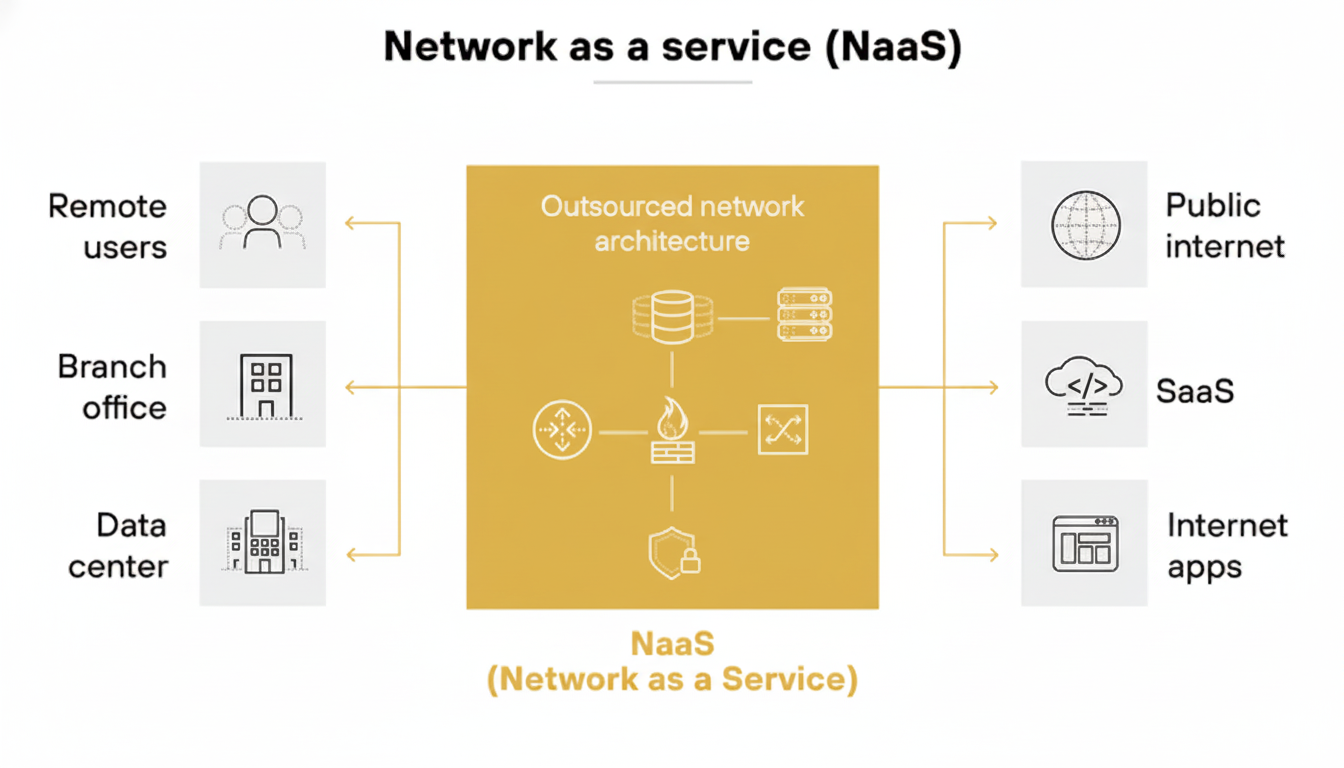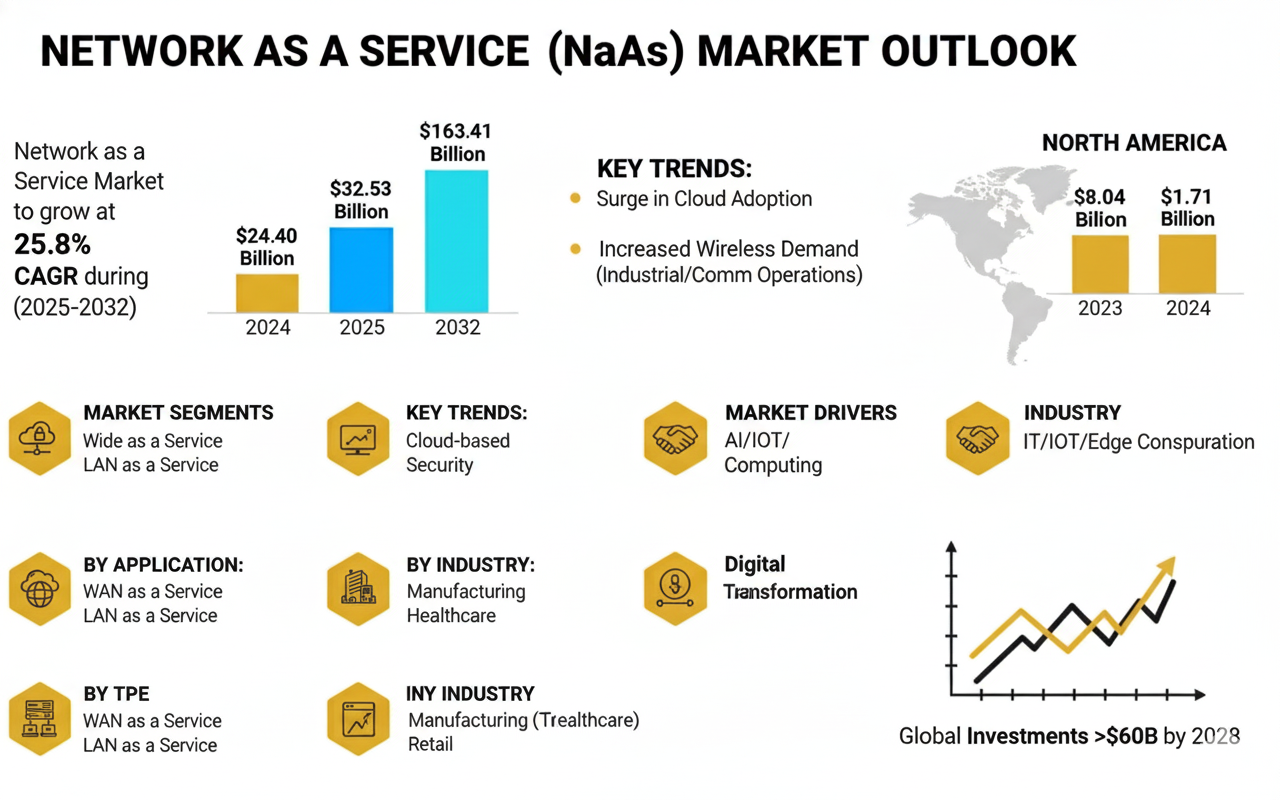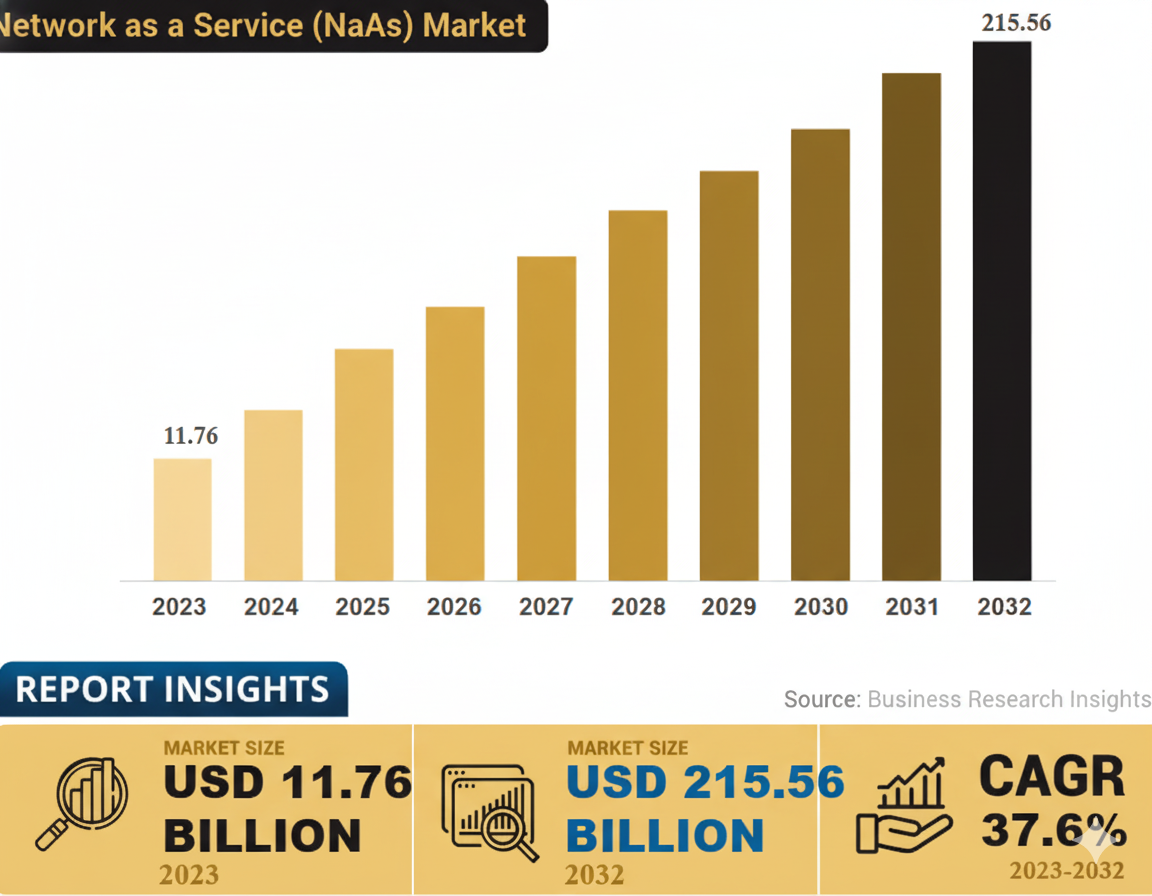October 15, 2025
.jpg)
Have you ever wondered why managing enterprise networks feels like a never-ending battle against complexity and costs? In today's fast-paced digital landscape, businesses are turning to innovative solutions to streamline their operations.
Network as a Service (NaaS) represents a transformative approach to enterprise connectivity, offering a flexible, cloud-based model that eliminates the burdens of traditional networking. This guide explores what NaaS entails, how it operates, and why it's becoming essential for organizations seeking scalable and efficient network solutions. Whether you're a CIO navigating digital transformation or an IT director optimizing resources, understanding NaaS can help you achieve better connectivity without the headaches of hardware management.
Network as a Service (NaaS) is a subscription-based network model that delivers networking infrastructure, management, and security through the cloud. Instead of purchasing and maintaining physical hardware like routers and switches, enterprises subscribe to a service provider who handles everything from deployment to ongoing operations. This model shifts networking from a capital-intensive endeavor to an operational expense, allowing businesses to pay only for what they use.
At its core, NaaS provides on-demand access to network resources, similar to how cloud services like SaaS operate. It includes features such as bandwidth allocation, traffic routing, and security protocols, all managed remotely. At Metro Wireless, we offer solutions that align with this model, leveraging our deep expertise in LTE and 5G to deliver reliable connectivity, as detailed by our team.
Enterprises are adopting NaaS for its flexibility and scalability. Traditional networks often require significant upfront investments and long deployment times, but NaaS allows quick adjustments to meet changing demands, such as expanding to new sites or handling seasonal traffic spikes. This shift supports digital transformation by enabling seamless integration with cloud environments and reducing the need for in-house IT expertise. Understanding the foundational elements involves grasping network infrastructure architecture and management, which forms the backbone of such systems.

NaaS operates through a combination of cloud-managed networking, software-defined wide area networks, and automation tools. Service providers maintain the underlying infrastructure, including hardware and software, while clients access it via a centralized platform or API.
The core components include cloud orchestration, where APIs enable dynamic configuration of network elements. For example, SD-WAN integrates with NaaS to optimize traffic flow across multiple connections, ensuring high performance and reliability. Providers manage the entire lifecycle, from initial setup to monitoring and updates, freeing enterprises from routine tasks.
Integration with private networks and enterprise cloud environments is seamless. NaaS can overlay existing setups, allowing hybrid models where on-premise systems connect to cloud resources. Network orchestration tools play a key role here, automating policy enforcement and resource allocation to maintain optimal performance.
In practice, this means businesses can scale bandwidth instantly or reroute traffic during outages without manual intervention. Our solutions, like fixed wireless internet exemplify this, offering up to 10Gbps speeds with SD-WAN capabilities for enhanced enterprise connectivity, supported by established deployment processes.
Adopting NaaS brings several advantages that address common pain points in enterprise network management. First, it simplifies operations through automation and real-time monitoring, reducing the time IT teams spend on maintenance.
Security is enhanced via managed services that include encryption, threat detection, and compliance features. Providers handle updates and patches, ensuring robust protection against evolving threats. For industries like healthcare or education, this means stronger safeguards for sensitive data, as outlined in discussions around private LTE networks.
Overall, NaaS supports better enterprise connectivity solutions by connecting branches, data centers, and remote workers seamlessly. It fosters network scalability and optimization, helping organizations stay competitive in a digital-first world. Client testimonials consistently highlight these benefits in real-world applications.

Traditional network models rely on ownership of physical hardware, leading to high upfront costs and ongoing maintenance responsibilities. In contrast, NaaS shifts to service-based management, where providers handle infrastructure, allowing enterprises to focus on core activities.
Deployment speed is a key difference: Traditional setups can take months, while NaaS enables activation in days or even hours. Flexibility is greater with NaaS, as it supports on-demand scaling without hardware upgrades. Security and maintenance also improve, with providers offering continuous monitoring and reduced downtime.
NaaS reduces hardware dependencies by virtualizing functions, minimizing the risk of obsolescence. This model is ideal for enterprises transitioning from legacy systems, providing a path to modern enterprise network solutions without complete overhauls. Comparisons with other technologies, such as fixed wireless internet versus fiber/coax cable, underscore these advantages.
Managed network services form the foundation of NaaS, involving the outsourcing of network operations to specialized providers. This relationship allows enterprises to leverage expert management without building internal teams.
In NaaS, managed services extend to end-to-end oversight, including design, deployment, and optimization. For example, managed SD-WAN enhances reliability by intelligently routing traffic and providing failover options. This is particularly beneficial for organizations with limited IT resources, as it ensures consistent performance.
Benefits include reduced operational complexity and access to advanced tools like cloud-managed networks. At Metro Wireless, we deliver these through our US-based team, offering white-glove service for mission-critical projects, as facilitated by network operations center support.
This integration helps enterprises achieve better control and efficiency, making NaaS a natural evolution of managed services. Collaboration extends to channel sales partners, ensuring broad accessibility.
Private networks play a vital role in NaaS, offering isolated environments for sensitive operations. Within NaaS, they integrate to provide secure, dedicated connectivity, ideal for enterprise campuses, healthcare, and education.
Use cases include segmenting data for compliance, such as HIPAA in hospitals or FERPA in universities. NaaS ensures data privacy through encryption and network isolation, protecting mission-critical workloads from public internet risks.
Security features like zero-trust models verify every access attempt, enhancing overall protection. Insights into private vs public networks and top trends in private 5G and LTE networks inform these strategies.
This approach supports enterprise connectivity solutions by balancing accessibility with stringent security standards. Additional considerations around private cellular network costs guide effective implementation.
NaaS shines in various enterprise scenarios. In smart campuses, it enables connected facilities with IoT integration and edge computing, transforming operations in education and corporate settings.
These use cases demonstrate NaaS's versatility in driving efficiency across industries, as evidenced in the top 10 use cases of private cellular networks and the business case for private wireless. Real-world examples appear in our case studies.
While promising, adopting NaaS involves challenges. Vendor dependency requires careful SLA management to ensure reliability. Data sovereignty and compliance, such as GDPR, must be addressed to protect sensitive information.
Integrating with legacy systems can be complex, often needing hybrid approaches. Conducting a cost-benefit analysis helps measure ROI, considering factors like reduced downtime versus subscription fees.
Selecting the right provider is crucial; look for those with proven expertise, like our US-first team at Metro Wireless. Thorough evaluation mitigates risks and maximizes benefits. Related technologies, including distributed antenna systems and explanations of what is a distributed antenna system is, offer complementary solutions.
Looking ahead, NaaS will evolve with AI-driven management for predictive analytics and automated optimizations. Synergy with 5G and edge computing will enable faster, low-latency applications.
The rise of zero-trust network architecture (ZTNA) will strengthen security, while autonomous networks promise hands-free operations. These trends position NaaS as a cornerstone of future enterprise connectivity.
Emerging options like managed Starlink and business managed WiFi integrate seamlessly, as explored in top trends in private 5G and LTE networks and exploring the future of business internet with Starlink and more.
In conclusion, NaaS offers a pathway to simplified, scalable networking that aligns with modern business needs. By addressing connectivity challenges head-on, it empowers enterprises to innovate and grow. If this guide has sparked ideas for your organization, share it with colleagues and explore how NaaS can transform your network strategy.

What does Network as a Service (NaaS) mean for enterprises?
It’s a subscription model that provides network infrastructure and management through cloud-based platforms, offering scalability and security without owning physical hardware.
How is NaaS different from managed network services?
Managed services handle specific network tasks, while NaaS delivers an end-to-end, cloud-managed network model under a unified service contract.
What are the key benefits of adopting NaaS?
Scalability, cost-efficiency, better performance visibility, automated management, and faster deployment.
How does NaaS support enterprise connectivity?
By enabling flexible and secure connections across multiple branches, data centers, and cloud services through SD-WAN and private network integration.
Is NaaS secure for sensitive data and enterprise operations?
Yes, modern NaaS solutions include encryption, segmentation, and compliance with security frameworks like ISO and SOC.
Can NaaS work with existing legacy network infrastructure?
Yes, hybrid models allow integration with on-premise systems while gradually transitioning to cloud-based operations.
What industries benefit most from NaaS?
Healthcare, education, manufacturing, finance, and large-scale enterprises that need consistent, secure connectivity.
With Network as a Service (NaaS), you can simplify how you connect, manage, and secure your network. Gain greater control, improve performance, reduce complexity, and scale effortlessly as your business grows.
At Metro Wireless, we help you design, deploy, and manage a cloud-based network that fits your goals. If you’re ready to modernize your infrastructure and achieve flexible, secure connectivity.
Connect with Metro Wireless today and build a cloud-powered network for the future.

Tyler Hoffman
CEO
